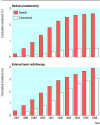Natural experiment examining impact of aggressive screening and treatment on prostate cancer mortality in two fixed cohorts from Seattle area and Connecticut
- PMID: 12364300
- PMCID: PMC128373
- DOI: 10.1136/bmj.325.7367.740
Natural experiment examining impact of aggressive screening and treatment on prostate cancer mortality in two fixed cohorts from Seattle area and Connecticut
Abstract
Objective: To determine whether the more intensive screening and treatment for prostate cancer in the Seattle-Puget Sound area in 1987-90 led to lower mortality from prostate cancer than in Connecticut.
Design: Natural experiment comparing two fixed cohorts from 1987 to 1997.
Setting: Seattle-Puget Sound and Connecticut surveillance, epidemiology, and end results areas.
Participants: Population based cohorts of male Medicare beneficiaries aged 65-79 drawn from the Seattle (n=94 900) and Connecticut (n=120 621) areas.
Main outcome measures: Rates of screening for prostate cancer, treatment with radical prostatectomy and external beam radiotherapy, and prostate cancer specific mortality.
Results: The prostate specific antigen testing rate in Seattle was 5.39 (95% confidence interval 4.76 to 6.11) times that of Connecticut, and the prostate biopsy rate was 2.20 (1.81 to 2.68) times that of Connecticut during 1987-90. The 10 year cumulative incidences of radical prostatectomy and external beam radiotherapy up to 1996 were 2.7% and 3.9% for Seattle cohort members compared with 0.5% and 3.1% for Connecticut cohort members. The adjusted rate ratio of prostate cancer mortality up to 1997 was 1.03 (0.95 to 1.11) in Seattle compared with Connecticut.
Conclusion: More intensive screening for prostate cancer and treatment with radical prostatectomy and external beam radiotherapy among Medicare beneficiaries in the Seattle area than in the Connecticut area was not associated with lower prostate cancer specific mortality over 11 years of follow up.
Figures




Comment in
-
Prostate specific antigen testing for prostate cancer.BMJ. 2002 Oct 5;325(7367):725-6. doi: 10.1136/bmj.325.7367.725. BMJ. 2002. PMID: 12364286 Free PMC article. No abstract available.
-
Screening populations at low risk carries high risks.BMJ. 2003 Jan 4;326(7379):53. doi: 10.1136/bmj.326.7379.53. BMJ. 2003. PMID: 12511476 Free PMC article. No abstract available.
References
-
- Potosky A, Miller B, Albertsen P, Kramer B. The role of increasing detection in the rising incidence of prostate cancer. JAMA. 1995;273:548–552. - PubMed
-
- Ries L, Eisner M, Kosary C, Hankey B, Miller BA, Clegg L, et al. SEER cancer statistics review, 1973-1997. Bethesda, MD: National Cancer Institute; 2000.
-
- Tarone R, Chu K, Brawley O. Implications of stage-specific survival rates in assessing recent declines in prostate cancer mortality rates. Epidemiology. 2000;11:167–170. - PubMed
-
- Hankey B, Feuer E, Clegg L, Hayes RB, Legler JM, Prorok PC, et al. Cancer surveillance series: interpreting trends in prostate cancer—part I: evidence of the effects of screening in recent prostate cancer incidence, mortality, and survival rates. J Natl Cancer Inst. 1999;91:1017–1024. - PubMed
-
- Feuer E, Merrill R, Hankey B. Cancer surveillance series: interpreting trends in prostate cancer—part II: cause of death misclassification and the recent rise and fall in prostate cancer mortality. J Natl Cancer Inst. 1999;91:1025–1032. - PubMed
Publication types
MeSH terms
Grants and funding
LinkOut - more resources
Full Text Sources
Medical
